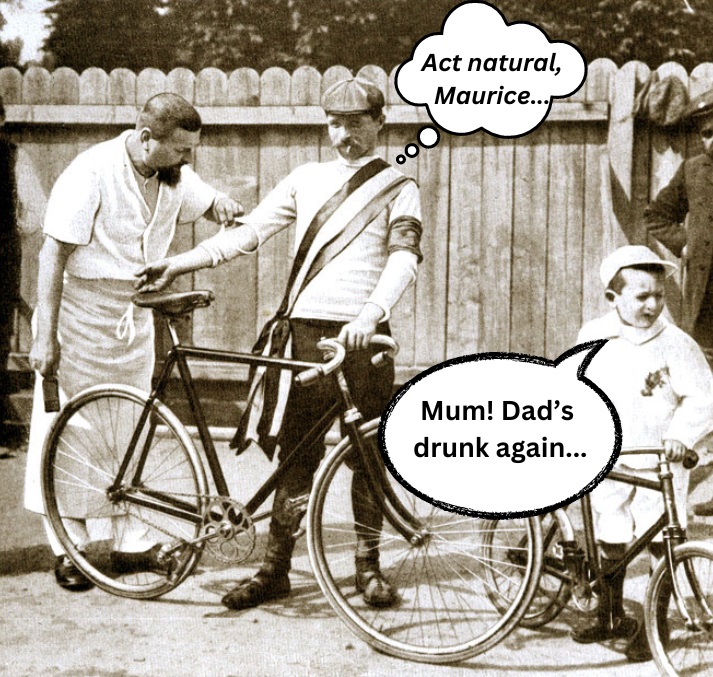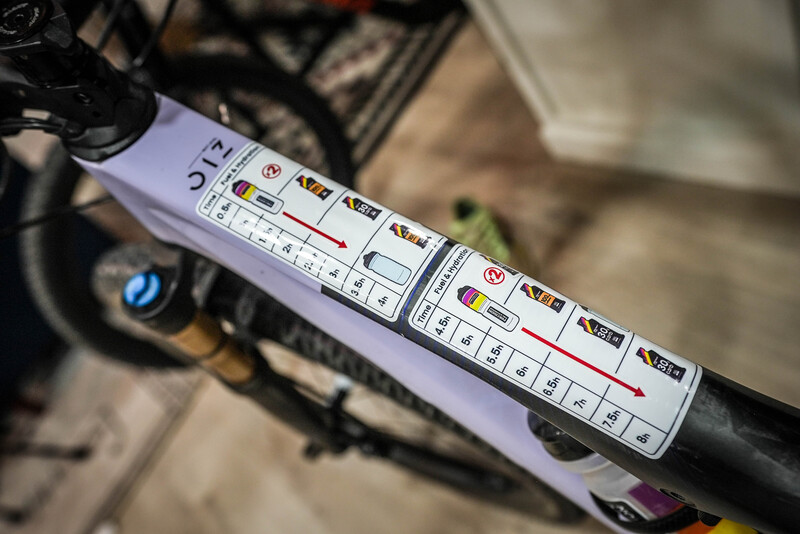In arguably the earliest case study of a race nutrition strategy, Maurice Garin recalled his intake during a French 24-hour bike race in 1893:
- Oysters
- Red wine and champagne
- Coffee
- 19 litres of hot chocolate
- 7 litres of tea
- 45 cutlets
- 5 litres of tapioca
- 2 kilograms of rice
Garin took a novel approach to overcoming flavour fatigue. 🤣 But it’s one that worked for him as he went on to win the very first Tour de France in 1903...
1903-1930: Cigarettes and alcohol
The ‘sports drinks’ of choice for Garin and his fellow riders during the inaugural TdF were alcoholic. The idea was that brandy, red wine and champagne would dull the pain of racing cumbersome, single-speed bikes up mountains for 18 hours a day, as well as being a more sanitary choice than drinking from roadside streams. And I suspect it made the whole experience a tad more fun...

A chimney sweep by trade, Garin swept to victory at the following year’s Tour. But he was stripped of his title when the top four from that edition were subsequently disqualified for various indiscretions, including catching trains to skip parts of the 2,428km course. I assume they were quaffing their favourite tipple in the first class carriage. 😉
Instead, it was Henri Cornet who was promoted to the top of the General Classification. The 19-year-old remains the youngest ever TdF winner and, according to The Science of the Tour, his daily race nutrition strategy involved:
- 11 litres of hot chocolate
- 4 litres of tea
- Champagne
- 1.5 kilograms of rice pudding
Musette bags were one of the first innovations for carrying fuel and hydration to be introduced during the 1920s, with bottle cages yet to be invented (probably because of the logistics of creating one big enough to fit a magnum of champagne). 🍾
The innovative musettes (which were based on the style of musettes used by the military at the time) were an ideal way to grab bags of snacks without stopping and they remain a feature of the pro peloton today.
There were some other ‘innovative’ ideas in the sport at this time, with riders smoking cigarettes to warm their hearts, ‘help’ their lungs and open their airways before big climbs...

1930-1965: Steaks and 'drinking raids'
In 1930, the Tour's organisers introduced national teams and there was a shift towards eating lots of meat during team meals. There was some merit to the idea that you needed to eat meat to “be strong”, as we now know that protein is crucial for muscle building and repair.
But it’s not the ideal fuel source for powering endurance exercise. That would be carbohydrates.
In 1939, a German study highlighted the potential benefits of consuming carbs for endurance performance. The slow move towards carbs continued to build when a 1951 paper called the ‘Feeding of Athletes’ suggested that athletes should consider using sugar for energy during prolonged exercise, as well as using salt when struggling with cramps.
Fausto Coppi, who won Le Tour in 1949 and 1952, was an early example of a rider using carbs for fueling.
In contrast to his rivals who were mostly smoking, drinking alcohol and loading up on veal, Coppi was replenishing his body’s glycogen stores using carb-based foods.
The man known as Il Campionissimo ('The Champion of Champions') carb-loaded with a breakfast of whole grains before consuming carbs in the form of tarts, fruit and sandwiches throughout races.
Despite the introduction of sponsored teams in 1962, we were still some way off the professional bottle hand-offs that we see today.
Instead, riders would drop their bikes and run into the local delicatessen to grab pastries, beers and whatever else they could get their hands on as part of ‘drinking raids'. The brilliant documentary, Vive le Tour, captures the art of these raids perfectly...
1965-1990: Vive le carbs
In 1965, Gatorade sports drinks arrived on the scene. The sports drink market was created as a response to the growing recognition that athletes required carbs, sodium and fluid to maintain performance - a concept that we dubbed 'The Three Levers'.
Two years later, it was discovered that stocking your muscles up with carbs before exercise resulted in you being able to exert yourself at a higher intensity for longer.
I won’t go into too much detail about how they discovered this, but it did involve the Hannibal Lecter-esque practice of cutting small chunks of muscle out of athletes’ legs. 🦵
Thankfully, this wasn't the start of a shift towards liver, fava beans and a nice chianti. Instead, the principle of carb-loading before exercise was born.
But riders were still chowing through tough cuts of meat before each stage. The five-time GC winner from 1969 to 1974, Eddie Merckx, told Stuart O’Grady:
"We’d have a small breakfast with the cheese and the ham and then steaks. It was horrible, but you know, you had to eat steaks to be strong. It was absolutely crazy."
It wasn't until Duran Duran's Hungry Like The Wolf was being blasted out of ghettoblasters in the '80s that teams started to take notice and ply their riders with carbs.
A study of the 1988 Tour concluded:
"The strategy of drinking large quantities of CHO-rich liquids seems to be the appropriate answer to maintain energy and fluid balance under these extreme conditions."
And the study reported that riders averaged ~5,900 calories a day and 94g of carbs per hour while racing...
Present day: An era of personalisation
Another major step forward in cycling nutrition came in the 1990s when teams started to add a chef to their backroom staff at the Tour. Although Lotto Dstny's soigneur Eric de Clerq told us that there were still some questionable food choices going in musette bags... 🍗🤣
As chefs brought a more professional approach to riders’ day-to-day diets, the early noughties saw riders start to target specific carb intakes during race stages.
The scientific community originally touted ~60g of carb per hour as the upper limit during long and intense efforts.
But that focus shifted upwards as teams began periodising carb intakes in order to “fuel for the work required”. So, whether riders consumed low, medium or high amounts of carb would be dictated by the profile of the stage and their individual needs.
Carbohydrate targets have continued to increase. The original 60g/h 'ceiling' was revised to 90g/h, and the target is now 100g/h and upwards for many riders in the peloton today. We saw Maxim van Gils hit ~105g/h when finishing 2nd during Stage 13 of the Tour in 2023.
Hitting those sorts of numbers can be a challenge. So, the nutritionists, who joined the chefs as key members of the team in recent years, create personalised plans for each rider. They often tape the plan to their stems to help them hit their numbers...

2023 Combativity Award winner, Victor Campenaerts, gave us an insight into the level of personalisation that's now a feature of the current approach to fueling a Tour stage when he outlined his race day intake...
Unlike the early 1900s, there isn't a champagne flute in sight, unless Victor finishes on the podium... 🍾
We’ve come a long way since the days of relying on cigarettes, steak and alcohol to fuel mammoth efforts in the French Alps. So, until scientific research says otherwise, let’s continue to save the champers for post-race celebrations...
